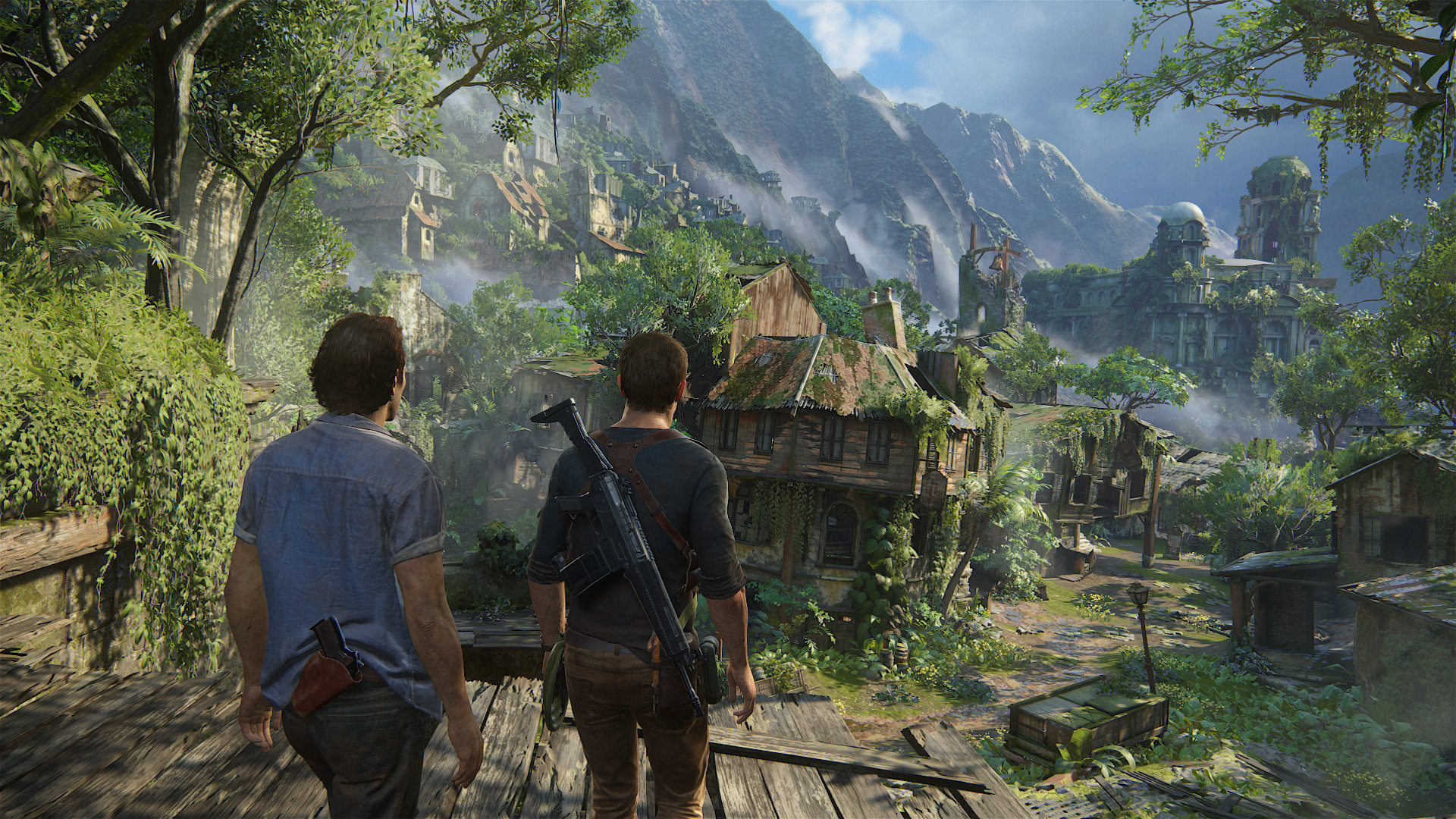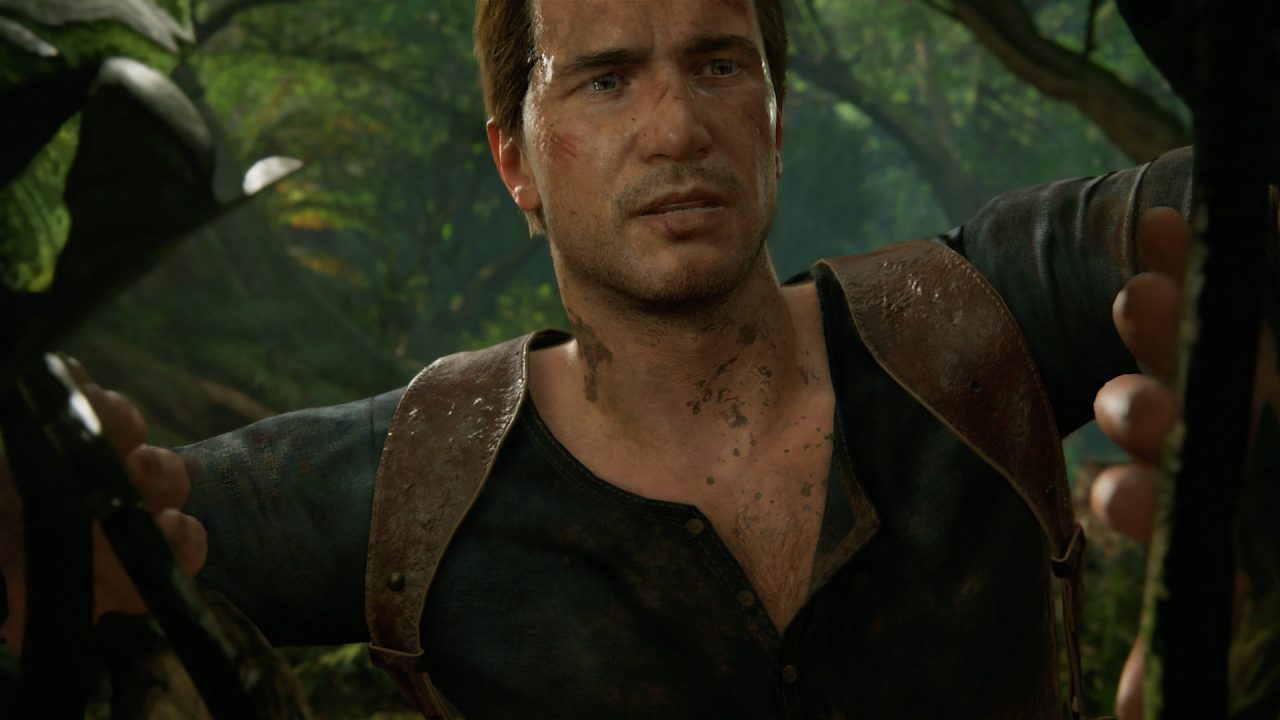gameplay 97 / story 99 / graphics 99 / sound 99
It was around the midway point of this game that something dawned on me: I’ve finally seen Nathan Drake at his most human, most vulnerable, and most desperate. I mean, this is the guy who always had a good time finding lost civilizations to plunder, and yet when the stakes are high, he begins to realize what that life has actually brought him. Forget about him as a plucky treasure hunter who doesn’t care about who gets in his way (except he always does), this is Nathan Drake: thrill seeker who’s now questioning every choice he’s ever made in his past and how it has affected his relationships over the years, including those he’s forgotten about for whatever reason. That’s ultimately the strength of Uncharted 4: A Thief’s End, the latest title in Naughty Dog’s acclaimed high adventure series. And it’s this latest adventure that sees Uncharted utilize all of its strongest elements, somehow improve them, and in the end creates the most grounded, human tale in the series, without sacrificing the pulpy adventure sensibilities that made it so charming in the first place.
Nathan Drake is now retired and married to Elena, living in a comfortable house in suburbia with a normal job. This has been his life for the past two years since Uncharted 3. However, things get turned around after Nate’s brother, Samuel Drake – thought to be dead for over fifteen years – resurfaces and calls out to Nate, asking him to go on yet another adventure. This adventure is one close to Nate from his childhood: looking for the lost treasure of Henry Avery, an infamous English pirate said to have the largest stockpile of hidden treasure, like, ever. It was to be his and Sam’s greatest achievement, and Nate can’t refuse the offer, since Sam’s life depends on the discovery of this lost treasure. Realizing what this means, he embarks on the adventure, while constantly struggling between his addiction to treasure hunting and wanting to live a normal life that doesn’t involve getting shot at. Meanwhile, an old enemy named Rafe Adler is also searching for this treasure, and has enlisted the help of Nadine Ross, the owner and leader of Shoreline: a private military company. Nathan just can’t catch a break, can he?
Those are the basics of the story, and for the first time in the Uncharted franchise, it actually starts to explain the characters instead of using them as vehicles for the treasure hunt. Don’t get me wrong, they were well-developed in previous games, and Nate himself is a well-rounded character in his own right. However, never have these character’s inner workings been explored, nor have the themes of obsession, addiction, the cost of glory, and leading two lives ever been so well explored. And this is saying something, since at its core, Uncharted is based of the pulp adventure stories that inspired Indiana Jones, cliches and all. The great writing exists here, with Nate’s witty remarks and his interaction with both friends and family remaining at the forefront of the entire narrative. Yet it also deconstructs those relationships, showing just what Nate has sacrificed in order to keep them, and what he’s willing to sacrifice to continue his thrill-seeking behavior, all without a cop-out explanation. I’ve rarely seen a story that actively tries to both deconstruct and reconstruct its own world all at once. And you know what? It totally works in this game.
It helps that each character is still just as memorable as ever. Besides the charming Nathan Drake, we have his wife Elena Fischer, who continually serves as his anchor to reality. There’s also Victor “Sully” Sullivan: Nate’s best friend and mentor who’s helped him in numerous adventures. Sadly, we don’t get to see either Chloe or Charlie Cutter, but we are introduced to Samuel Drake, Nate’s long-lost brother. Samuel, in all regards, is where Nate gets most of his character traits. His constant joking around, his insane knowledge of history, his never-ending determination to find whatever treasure he’s hunting for, and then some. However, Sam is also a deconstruction of Nate. Basically, what Nate would be like if he never wanted a normal life in any capacity. It presents a new facet of the narrative that pits Nate, basically, against the part of him he had left behind for two years, and makes for some interesting commentary on Nate’s character.
All of this is explored in possibly the finest looking game on the Playstation 4 to date. I’m not one for hyperbole, but this is, without a doubt, the single most beautiful game I’ve yet to see in quite some time. Everything from the rocks you climb on, the sweeping vistas you see, the plant life you interact with, and even the character models all have a near uncanny realism to them that leaves you in constant awe no matter what you’re looking at. Seriously, the level of detail here is almost frightening, it’s so well done. You shoot at piles of rubble, and the rocks that fly out will bounce off other objects as in real life. The trails you leave in mud, snow, and sand are well made and interactive with all your movements. And that’s not to even mention the way characters move around and talk. Their features move in a realistic way, their eyes don’t look dead in any way, and their clothes twist and turn to their every single movement in ways that are much more believable than previously could be achieved with older technology. Uncharted 4 is absolutely gorgeous in its art direction as well, as it uses amazing color palettes for every single location you find yourself in. Basically, it’s stunning to look at, is what I’m trying to say.
Now let’s get on to the main event: the gameplay. The Uncharted franchise is equal parts a third-person cover-based shooter and an exploration game that allows you to climb on the sides of buildings, rock cliffs, and other various structures to get from A and B. However, a few changes have been made to the formula that allow the game to feel so much better than previous entries. First off, the levels you find yourself in are much larger than before. Rather than seeing your path directly in front of you and being subtly guided there with cleverly colored rocks, you’re invited to stick around and just…walk and run and climb and explore these sections. More often than not, you’re given a few optional prompts to look at certain items and see what their significance is, which is a first for the series. It’s not open-world design, but rather open-ended, as the path towards your goal is still a linear one. Albeit one with many, many ways of traveling to the same location. Sure, you still get the staple of certain handholds collapsing under your weight, but they’re far fewer than ever here, leaving you to feel as though you have some control over where you’re going and what you’re supposed to be holding on to.
In spite of this, the methods of traversing these perilous areas have changed as well. While Nathan Drake’s fingers still have the godlike grip of a human gorilla, he still can’t jump very far on his own. For this reason, he now uses a rope hook, which he can now use to swing across wide chasms, anchor himself as he lowers himself down more lethal drops, and even drag items around to assist with some puzzles. Now, it’s very easy to think that this is some sort of cheap gimmick, but the way it’s incorporated into the game is to be commended, as you not only need it to travel through many areas, but it also has numerous combat applications, which I’ll get into later. Aside from this, there are also sliding slopes full of loose rubble, mud, or even ice here and there that allow for a different kind of traveling altogether. Using these in conjunction with one another is almost vital for progression, and is every bit as thrilling the fortieth time as it is for the first.
Just as thrilling as ever are the set-pieces, and they are no less impressive here than in previous titles like Uncharted 2 and 3. These are the moments where Nate is caught in some sort of cross fire or collapsing structure, and rather than having everything play out in a cutscene, the game gives you the wheel and asks you to take control in order to escape these sequences. Whether you’re driving along the highway to catch a convoy before roping yourself to one of the vehicles while simultaneously taking out mercenaries shooting at you, or jumping from building to crumbling building in a lost ancient ruin while said mercs rain RPG hell on you, trying your hardest to avoid death, no sequence is the same, and not one feels the least bit stale or joyless. Everything here is as thrilling as ever, even if their impact has been lessened by the fact that it is now mandatory to have these sequences in this franchise.
However, the danger doesn’t just come from set-pieces alone, as you do eventually find yourself dealing with armed Shoreline mercenaries just itching to put a bullet between your eyes and ending your hunt. Fortunately, Nate is an expert marksman, and is able to hold his one quite well against such insurmountable odds. As stated before, this is a cover-based shooter, so hiding behind cover to avoid a lead salad is the wisest thing to do most times. Except now, most forms of ground cover are destructible, and will leave you vulnerable if you don’t keep moving around, or if the cover button occasionally decides to be touchy and land you in the middle of fire instead of behind the rock you wanted to hide behind. The arenas you fight in are more open now, allowing you to climb to much higher vantage points, use the rope hook to swing to better ground, or even use it to swing onto unsuspecting mercs and tackling them to the ground. All of this comes with much tighter controls than before. Guns no longer feel or sound loose, and pack a punch that was desperately needed with this franchise, so that enemies no longer feel like bullet sponges, but rather natural targets getting hit with powerful guns.
Of course, seeing as how mercenaries are trained to kill and are especially deadly in a large group, the game also allows the option to silently take them out one by one. That’s right, Uncharted 4 has stealth mechanics now, and it actually works with the flow of the game, believe it or not. You now have tall grass you can hide in as you creep up on goons. You can tag enemies to follow their paths in order to determine your best route for success. You can lure enemies to specific locations before unleashing a grenade at a group, or kicking a poor man off a tall cliff as he looks for you on the ledge below. Enemies do have a meter that lets you know how close they are to spotting you, and you can use that to your advantage as well. I never thought that introducing mechanics from The Last of Us would fit in the high stakes world of Uncharted, but here it is, and it works. You tell me, because I’m still speechless.
The sound design is one of the key reasons why combat feels so much better now than it ever did. Every gun you fire sounds loud and bold, instead of poppy and metallic like you were firing cheap knockoffs. The voices are crystal clear, the sound of you rustling through grass, rock, and anything else you can think of is accurate and well mixed. Hell, even the soundtrack to the game, with a completely different composer, still manages to evoke both the heart-pounding thrill of the chase while at the same time packing more emotion into the quieter scenes.
As with the previous two titles, Uncharted 4 comes with competitive multiplayer. You have your basic team deathmatch mode, a command mode similar to domination modes, and also a Plunder mode, which is essentially a team-based treasure hunt mode across the map. You can use the same skills from the campaign in the multiplayer, such as the grappling hook, in maps that are much larger than before to allow for the chaotic flow of battle to compliment the changes in the mechanics. Throughout any match, you can find treasures that give you in-match cash. This cash allows you to buy mystical abilities and other powerups to assist you in battle. For instance, you can summon sidekicks, either one that uses a heavy machine gun to mow down the competition, a sniper, a savior (basically a healer), or even a hunter that roams the map to silently kill an enemy player. The mystical artifacts are support tools, such as a stone that instantly revives teammates, a demonic pillar that shoots spirits at opposing players, or even a spirit that gives you the ability to teleport.
Honestly, I’ve always sort of enjoyed Uncharted’s more chaotic take on multiplayer. It’s not always meant to be a team-based match of skill, but rather a test of how much anarchy you can create for your enemies while being able to climb and stuff. It’s a fun distraction that is ultimately there to be a good time, with the occasional daily challenges, and a decent progression system that’s become the staple of most multiplayer offerings. In fact, I only have two issues with the multiplayer. The first is the lack of co-op modes at launch. Co-op was one of the best parts of the Uncharted multiplayer experience for me, and it’s a shame they’re waiting until later to give it to us. Also, and this is the one that I struggle to understand, is the inclusion of microtransactions for in-game currency. Now, to be fair, this currency only unlocks cosmetic items and extra MP characters that you can easily obtain through playing the game, and have no real impact on the gameplay. But I still struggle to understand this need for developers to constantly have players paying more money for a game they’ve already bought to enjoy. This is not the worst example of microtransactions in a game, mind you – far from it, in fact – but it still feels a bit wrong on some level.
Regardless, if you’ve ever wanted to know what a system seller looks like, look at Uncharted 4: A Thief’s End, and then pick it up and experience it. Because that’s what this game is: one hell of an experience. It’s a high adventure with high stakes and a great narrative. The characters are all memorable and well-acted, the gameplay is beyond improved from previous outings, the graphics of some of the best you’ll find on either console or PC, and there’s so much care and detail put into it that it’s hard not to overlook any of it. You owe it to yourself to play through Nathan Drake’s last adventure, and see how far he’s willing to go and what he’s willing to sacrifice to live the life he wants to live with the people he holds dear to his heart. While also slaughtering hundreds of mercenaries like the sadistic prick he’s wrongly attributed to being. Hey, who am I to judge? I’m only the one controlling him, right?
Did you enjoy this review? Want to post your own review? Anyone can report the news, or post a review on gamelust.com, AND have a chance to become featured on our homepage! All you need to do is log in or register with us and add your voice today!
You must be logged in to leave a comment













